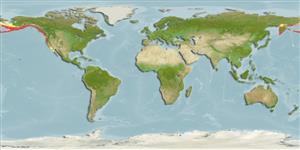>
Pleuronectiformes (Flatfishes) >
Pleuronectidae (Righteye flounders) > Microstominae
Etymology: Glyptocephalus: Greek, glyptes = carver + Greek, kephale = head (Ref. 45335); zachirus: From the Greek za and cheir, meaning 'long'and 'hand' (Ref. 27436).
Environment: milieu / climate zone / depth range / distribution range
Ökologie
seewasser demersal; tiefenbereich 0 - 900 m (Ref. 50610), usually 61 - 500 m (Ref. 2850). Temperate; 65°N - 28°N, 155°E - 115°W
North Pacific: from Kuril Island to Bering Sea coasts of Russia and Alaska (Ref. 27436) to Cedros Island, northern Baja California, Mexico.
Length at first maturity / Size / Gewicht / Alter
Maturity: Lm ? range ? - ? cm
Max length : 60.0 cm TL Männchen/unbestimmt; (Ref. 56527); common length : 36.0 cm TL Männchen/unbestimmt; (Ref. 56527); max. veröff. Gewicht: 2.0 kg (Ref. 56527); max. veröff. Alter: 27 Jahre (Ref. 55701)
Kurzbeschreibung
Morphologie | Morphometrie
Rückenflossenstacheln (insgesamt): 0; Rückenflossenweichstrahlen (insgesamt): 87-110; Afterflossenstacheln 0; Afterflossenweichstrahlen: 78 - 93; Wirbelzahl: 62 - 65. Dorsal origin above middle of upper eye. Posterior margin of caudal like a 'V'. Pectoral on eyed side greatly elongated.
A slow-growing species found on sand or mud bottoms (Ref. 2850). Usually discarded by trawlers but sometimes processed into fertilizer (Ref. 27436). Flesh considered tasty (Ref. 27436). Utilized fresh and frozen; eaten steamed, fried, microwaved and baked (Ref. 9988).
Vinnikov, K.A., R.C. Thomson and T.A. Munroe, 2018. Revised classification of the righteye flounders (Teleostei: Pleuronectidae) based on multilocus phylogeny with complete taxon sampling. Molecular phylogenetics and evolution, 125:147-162. (Ref. 122998)
IUCN Rote Liste Status (Ref. 130435)
Bedrohung für Menschen
Harmless
Nutzung durch Menschen
Fischereien: kommerziell
Tools
Zusatzinformationen
Download XML
Internet Quellen
Estimates based on models
Preferred temperature (Ref.
123201): 1 - 7.5, mean 3.7 °C (based on 619 cells).
Phylogenetic diversity index (Ref.
82804): PD
50 = 0.6250 [Uniqueness, from 0.5 = low to 2.0 = high].
Bayesian length-weight: a=0.00490 (0.00297 - 0.00808), b=3.13 (2.98 - 3.28), in cm total length, based on LWR estimates for this species & (Sub)family-body (Ref.
93245).
Trophic level (Ref.
69278): 3.3 ±0.1 se; based on diet studies.
Widerstandsfähigkeit (Ref.
120179): niedrig, Verdopplung der Population dauert 4,5 - 14 Jahre. (tm=3-6; tmax=27).
Prior r = 0.06, 95% CL = 0.04 - 0.10, Based on 1 stock assessment.
Fishing Vulnerability (Ref.
59153): Moderate vulnerability (44 of 100).
Climate Vulnerability (Ref.
125649): Low to moderate vulnerability (32 of 100).
Nutrients (Ref.
124155): Calcium = 25.9 [10.7, 47.1] mg/100g; Iron = 0.241 [0.123, 0.458] mg/100g; Protein = 16.8 [15.5, 18.2] %; Omega3 = 0.346 [0.172, 0.726] g/100g; Selenium = 23.6 [11.9, 49.1] μg/100g; VitaminA = 8.72 [2.05, 36.29] μg/100g; Zinc = 0.448 [0.303, 0.659] mg/100g (wet weight);
